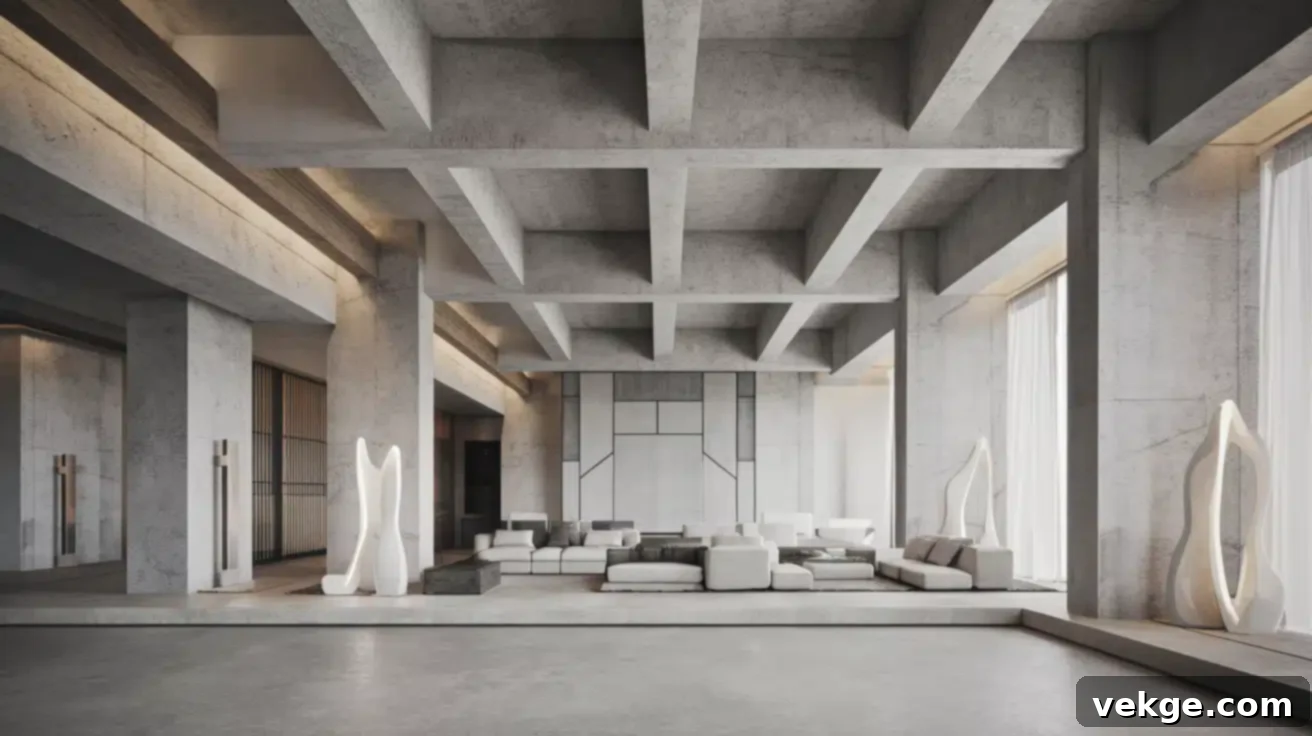Mastering Minimalist Brutalist Interior Design: A Modern Guide to Raw, Refined Spaces
Are you dreaming of a home that’s bold, uncluttered, and refreshingly honest? Minimalist Brutalist interior design might be the perfect style to transform your living space. This unique approach celebrates raw materials, clean lines, and purposeful design, creating environments that are both striking and incredibly functional.
Imagine a space free from unnecessary adornment – no frills, no fluff, just the intrinsic beauty of strong materials, clear architectural forms, and a profound sense of purpose. It’s a design philosophy that champions simplicity and authenticity, making your home feel grounded and truly practical.
If you’re seeking a sophisticated yet straightforward aesthetic that cuts through the noise of modern clutter, this comprehensive guide is for you. We’ll explore everything from the stark elegance of exposed concrete to the thoughtful selection of functional furniture, offering actionable ideas you can readily implement. Whether you’re refreshing a single room or envisioning a complete home overhaul, you’ll find inspiration here to craft a space that perfectly aligns with a raw, modern, and minimalist sensibility.
Let’s dive into the world of Minimalist Brutalist design and discover how to bring its enduring appeal into your home!
What Exactly is Minimalist Brutalist Interior Design?
Minimalist Brutalist interior design is a captivating blend of two powerful architectural movements: Brutalism and Minimalism. It’s a style that champions robust, unpretentious aesthetics by combining raw, honest materials with clean lines and simple, geometric shapes. The core principle is function over decoration, allowing the inherent beauty and texture of materials like concrete, steel, and natural wood to take center stage.
In a truly Minimalist Brutalist space, every element serves a distinct purpose, contributing to an overall sense of calm and order. This deliberate approach eliminates visual clutter, allowing the architecture and materials themselves to define the room’s character. Exposed structural elements, unfinished surfaces, and robust textures add depth and a unique tactile quality, making the design feel authentic and strong.
Emerging from the Brutalist architectural movement of the 1950s, which itself was a reaction to overly decorative and ornate styles, this interior design adaptation has evolved into a highly sought-after contemporary aesthetic. Today, it’s celebrated for its enduring appeal, durable materials, and unwavering focus on simplicity. It provides a perfect solution for those who desire stylish, highly functional homes imbued with a raw, grounded, and unmistakably modern feel.
Key Materials that Define Minimalist Brutalist Interiors
The selection and application of materials are paramount in minimalist brutalist interior design. These materials aren’t just finishes; they are the very building blocks that communicate the style’s raw and honest essence.
- Concrete: The Signature Element: Concrete is arguably the most iconic material in this style, setting the foundational tone for any space. Its versatility allows it to be used for walls, floors, ceilings, and even bespoke furniture or countertops. You can opt for smooth, polished concrete for a sleek, contemporary look, or embrace rough, unfinished concrete for a more industrial and textural feel. Its natural grey tones provide an ideal neutral backdrop.
- Steel and Glass: Structure and Light: Steel and glass bring a sense of industrial strength and refined transparency. Steel is frequently employed in light fixtures, shelving units, furniture frames, and stair railings, providing structural integrity and sharp, defined lines. Glass, often used for partitions, tabletops, or windows, introduces light and openness, preventing the robust materials from feeling too heavy or enclosed. Together, these materials give a room a clean, strong, and subtly edgy character.
- Wood: Adding Warmth and Balance: While concrete and steel offer a cool, hard aesthetic, wood is introduced to provide essential warmth and a touch of organic softness. Natural, unfinished, or minimally treated wood – such as oak, walnut, or even reclaimed timber – brings a vital sense of balance. It can be integrated through flooring, accent walls, furniture, or even ceiling beams. The rich grain and inherent imperfections of wood ensure the space feels inviting and comfortable without compromising the raw, minimalist brutalist aesthetic.
- Other Textural Elements: Beyond these core materials, elements like exposed brick, natural stone, or even raw plaster can be used to add further textural depth and visual interest, reinforcing the design’s commitment to honesty and authenticity.
Embracing the Aesthetic: Minimalist Brutalist Interior Design Ideas
This section offers practical and inspiring ideas to help you infuse the distinctive raw and functional vibe of minimalist brutalism into every corner of your home. From bold architectural statements to subtle textural contrasts, each tip is designed to guide you in creating spaces that are both powerfully aesthetic and eminently livable.
1. Exposed Concrete Walls or Floors
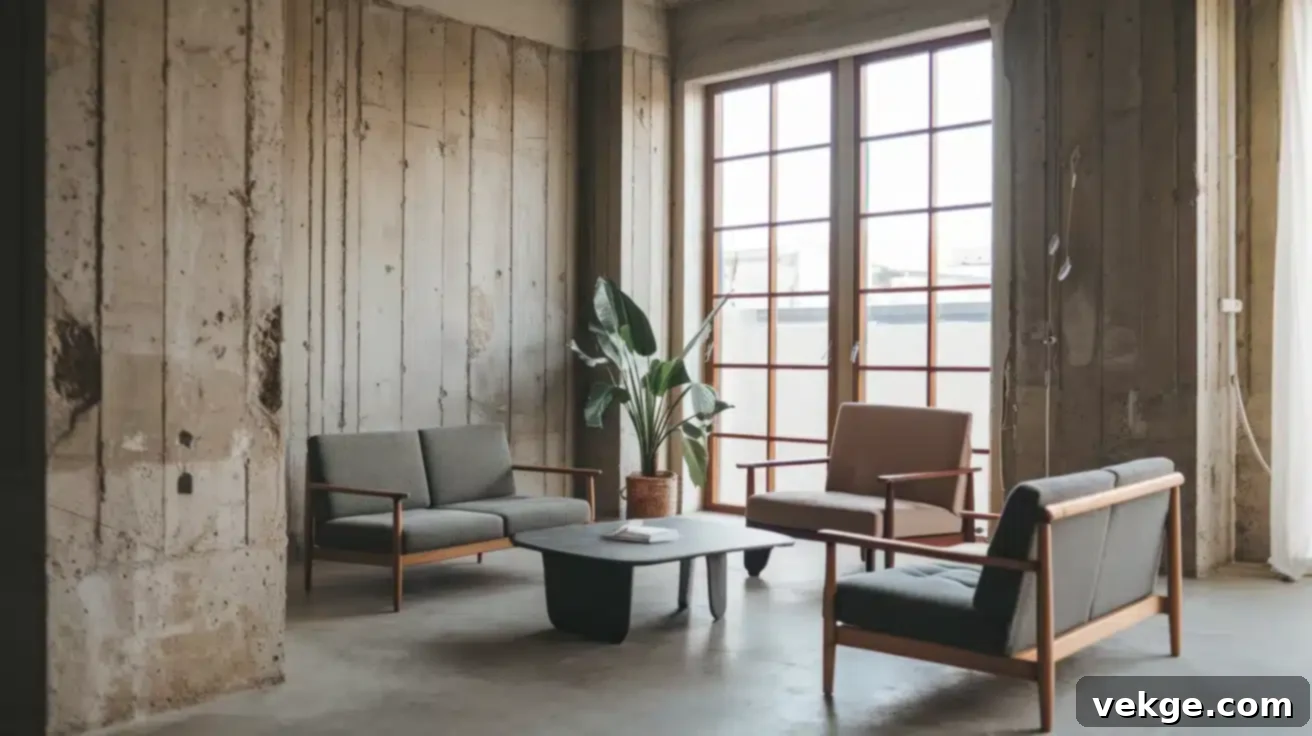
Concrete is the cornerstone of minimalist brutalist interior design. Leaving walls or floors exposed creates a raw, architectural finish that instantly adds strength and a sense of honesty to the space. You can choose a smooth, polished concrete for a sleek, modern vibe or opt for a rough, textured finish to lean into an industrial aesthetic. Beyond its striking appearance, concrete is incredibly low-maintenance and durable, making it a practical and stylish choice that forms the robust foundation for your entire design.
2. Functional, Clean-Lined Furniture
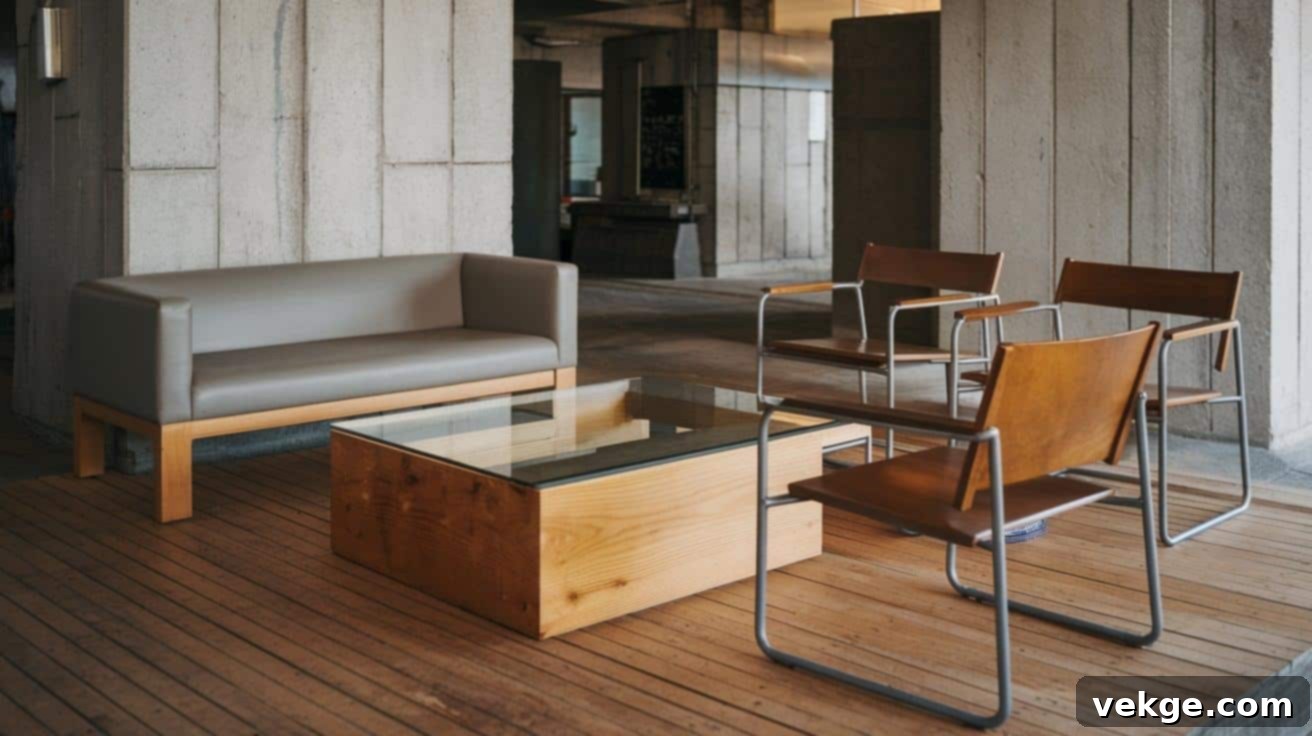
Furniture in this style prioritizes function and simplicity above all else. Pieces should feature clean, unambiguous lines, completely devoid of superfluous decoration, and serve a clear, practical purpose. Envision sturdy wooden tables with robust forms, metal-framed chairs with minimalist profiles, and sofas designed with straightforward, geometric shapes. Multi-functional items, such as a storage-integrated bench or a sleek, open bookshelf, are particularly effective. This approach ensures the space remains uncluttered, highly usable, and perfectly aligned with the strong, straightforward ethos of brutalist interiors.
3. Gray, Black, and Neutral Color Palette
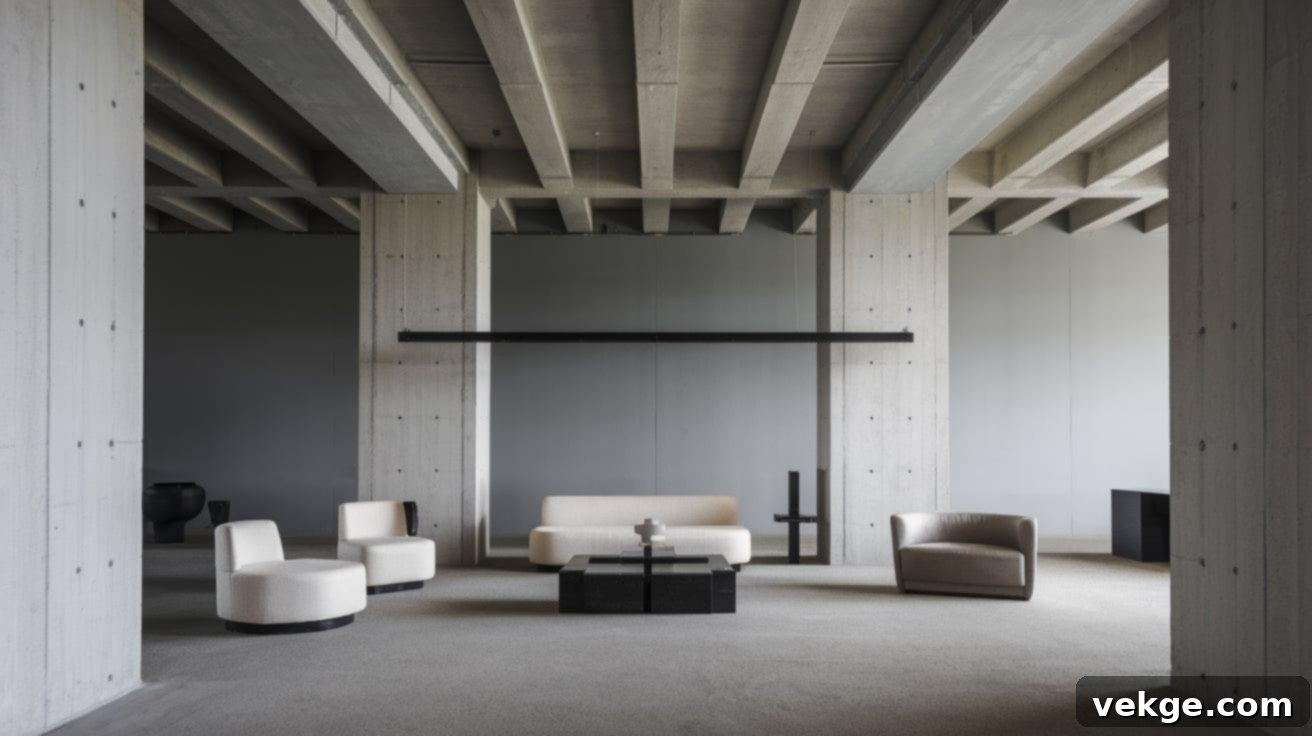
A minimalist brutalist interior typically relies on a muted color palette to create a serene and cohesive backdrop. Shades of gray, black, white, and various neutrals like beige and taupe are predominant. These understated colors effectively highlight the intrinsic textures of materials such as concrete, steel, and wood without overwhelming the space. The emphasis shifts from vibrant hues to the interplay of form, surface, and light. You can introduce depth by layering various tones within this neutral spectrum, allowing any carefully chosen bold accent or artwork to stand out with greater impact.
4. Raw Wood Accents
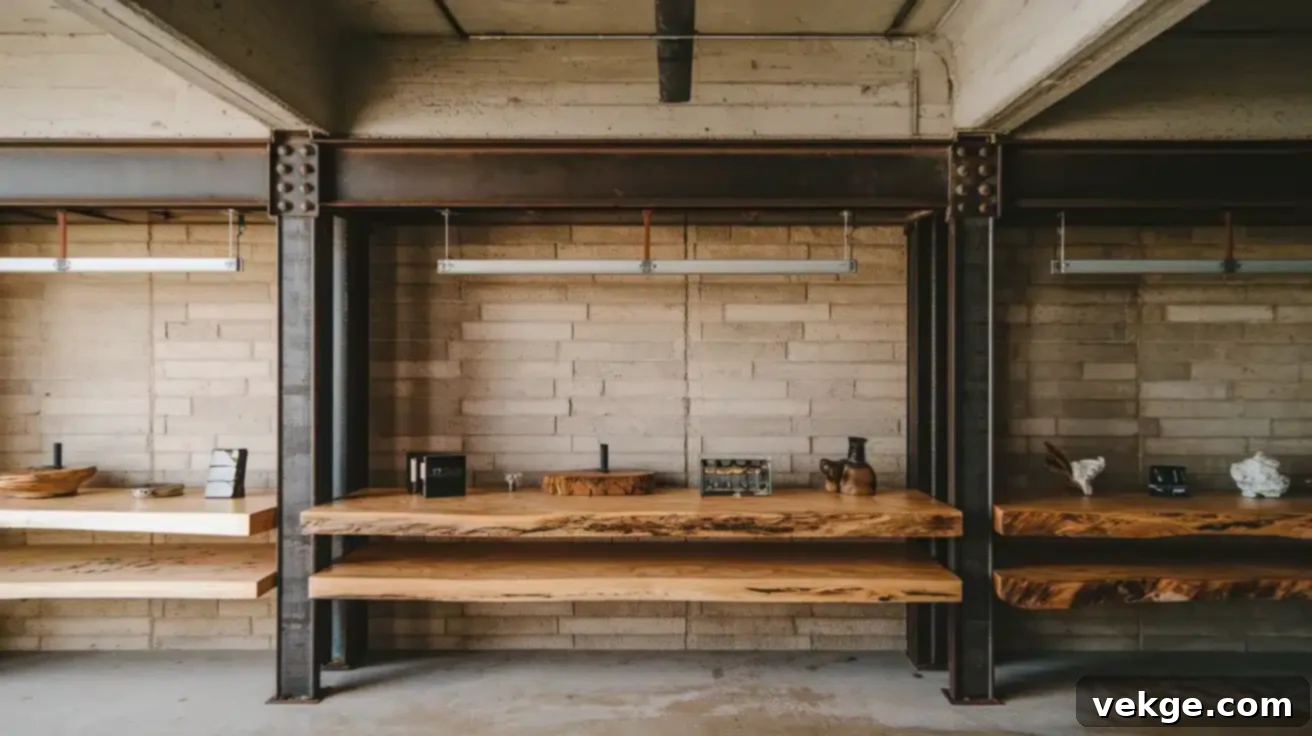
To beautifully contrast the often cool and hard surfaces of concrete and steel, integrating raw or unfinished wood accents is crucial. Wood introduces natural warmth and an organic quality that softens the overall aesthetic. It can be skillfully utilized for shelving, furniture, structural beams, or even small, thoughtfully selected decor pieces. The visible grain, tactile texture, and natural imperfections of the wood add a touch of softness and visual interest, preventing the space from feeling overly rigid or sterile, while still upholding the robust, minimalist style.
5. Green Plants for Balance
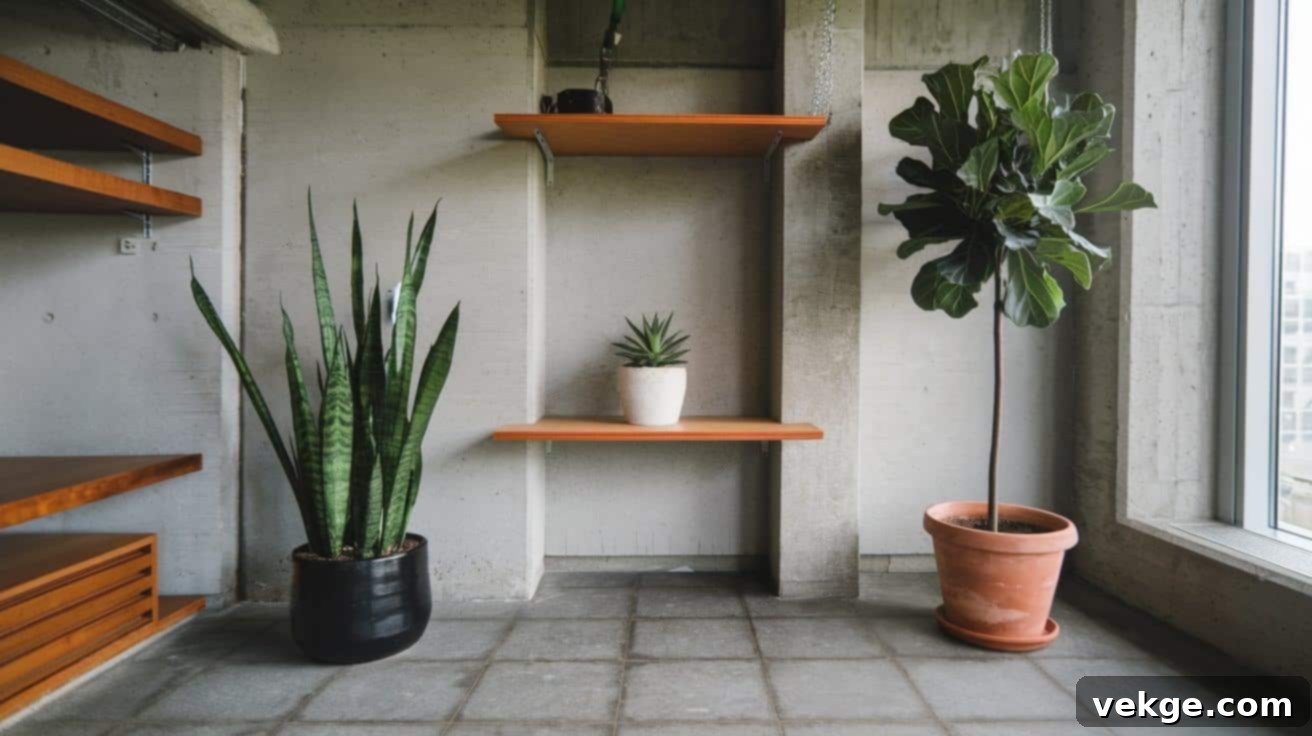
Introducing green plants is an excellent way to soften the bold, defined edges inherent in brutalist design. Even a few strategically placed, leafy green plants can profoundly impact the atmosphere. Opt for low-maintenance varieties such as snake plants, succulents, ZZ plants, or fiddle-leaf figs. Their organic shapes and vibrant hues provide a stunning visual contrast to the structured, hard materials surrounding them. Beyond aesthetics, plants enhance air quality and make the space feel more alive, welcoming, and calm – the perfect touch of life without introducing clutter.
6. Minimal Accessories and Decor
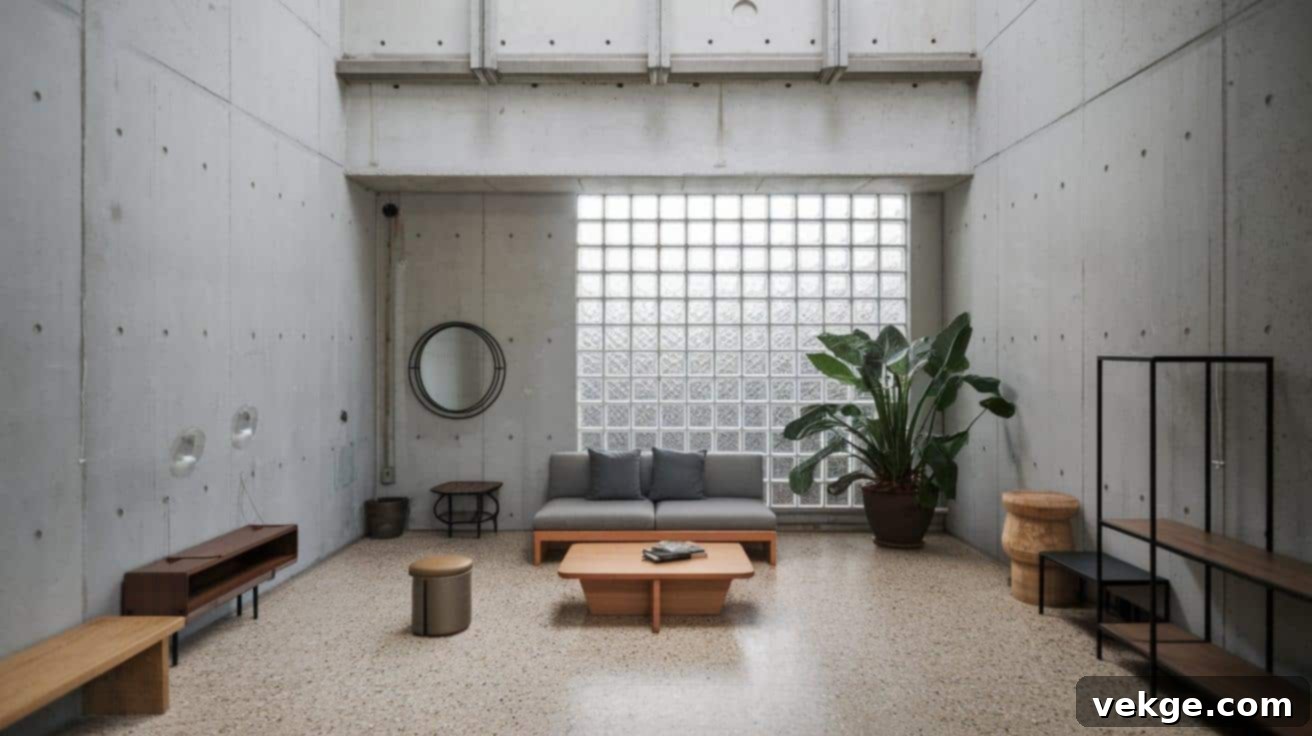
In minimalist brutalist interior design, restraint is key. The philosophy dictates avoiding clutter and focusing on a few carefully chosen, meaningful items. Rather than filling shelves with an assortment of trinkets, select one or two standout pieces—perhaps a sculptural vase, a striking ceramic bowl, or a single art object. Every accessory should possess either significant visual impact or a clear functional purpose. This disciplined approach keeps your space pristine and focused, allowing the rich textures and architectural elements to truly shine. Minimal accessories also contribute to a sense of spaciousness, calm, and deliberate design.
7. Sculptural Metal Light Fixtures
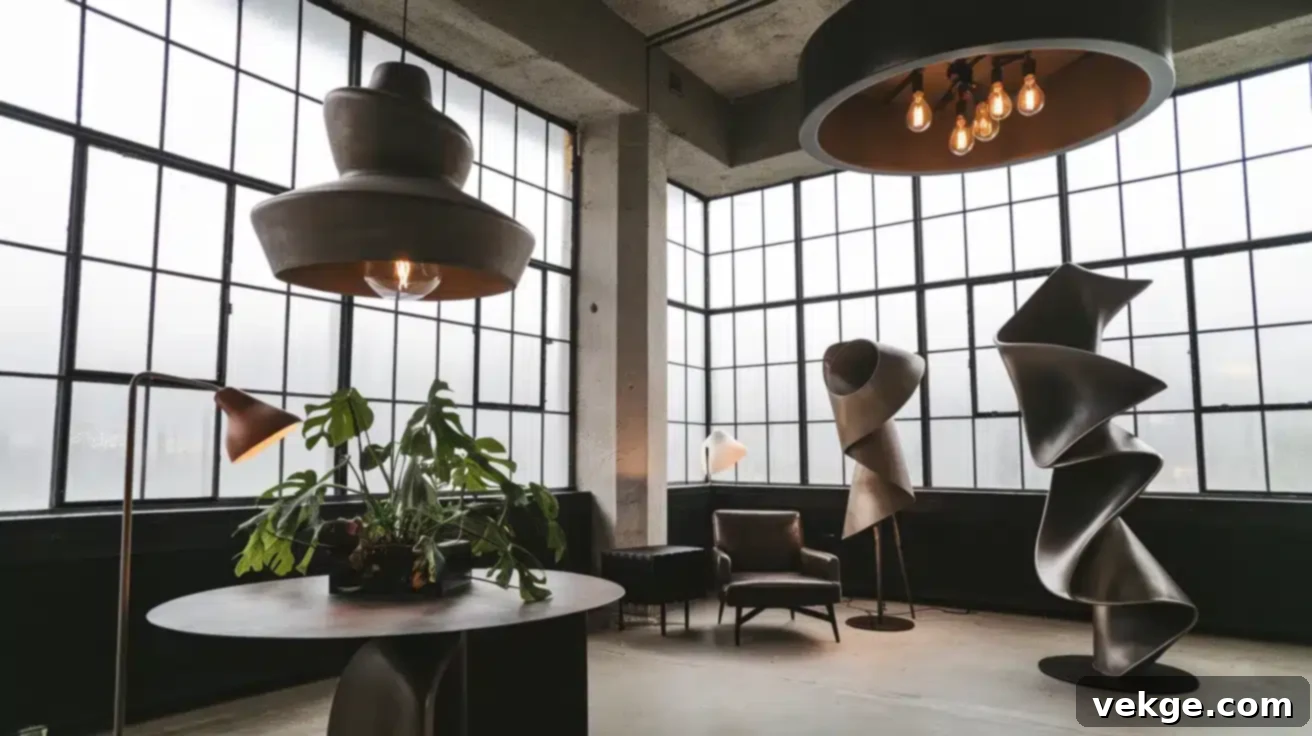
Lighting in brutalist spaces is far more than merely functional; it’s an integral design element. Sculptural metal light fixtures add distinct shape, industrial texture, and a touch of artistic expression to the room. Seek out industrial-style pendant lights, floor lamps with sharp, geometric lines, or ceiling lights that proudly feature exposed bulbs. Finishes in matte black, raw metal, or even concrete-look materials perfectly complement the style. These lighting elements don’t just illuminate; they become captivating focal points that enhance the raw, industrial feel of your interior without requiring additional decorative items.
8. Industrial Features Like Pipes and Beams
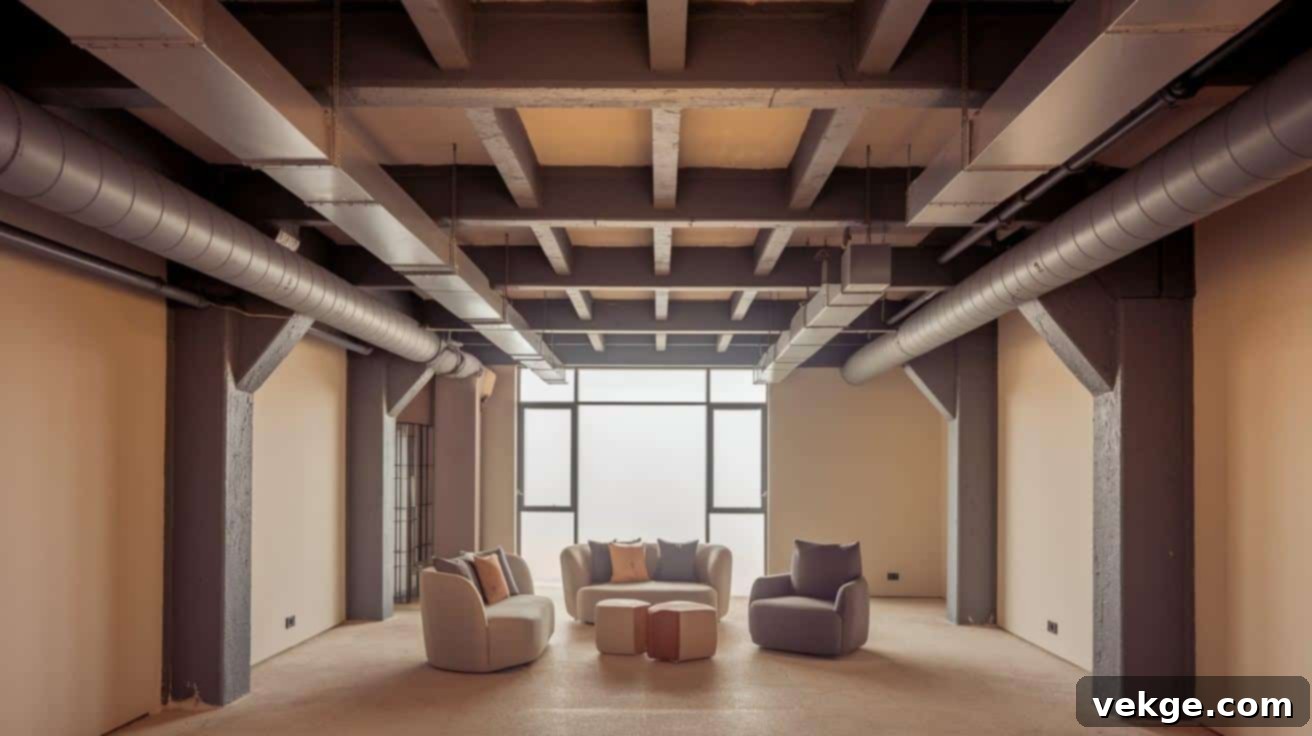
Instead of concealing them, embrace exposed pipes, ceiling beams, or ductwork as intentional design features in minimalist brutalist interiors. Their raw lines and inherent materials add compelling visual interest and powerfully reinforce the space’s honest, structural aesthetic. Consider painting them a neutral or dark tone—such as matte black or a deep gray—to integrate them seamlessly into the overall scheme. These industrial elements add an authentic layer of texture and narrate a subtle story about the building’s underlying structure, enhancing the brutalist character.
9. Open Layouts for an Airy Feel
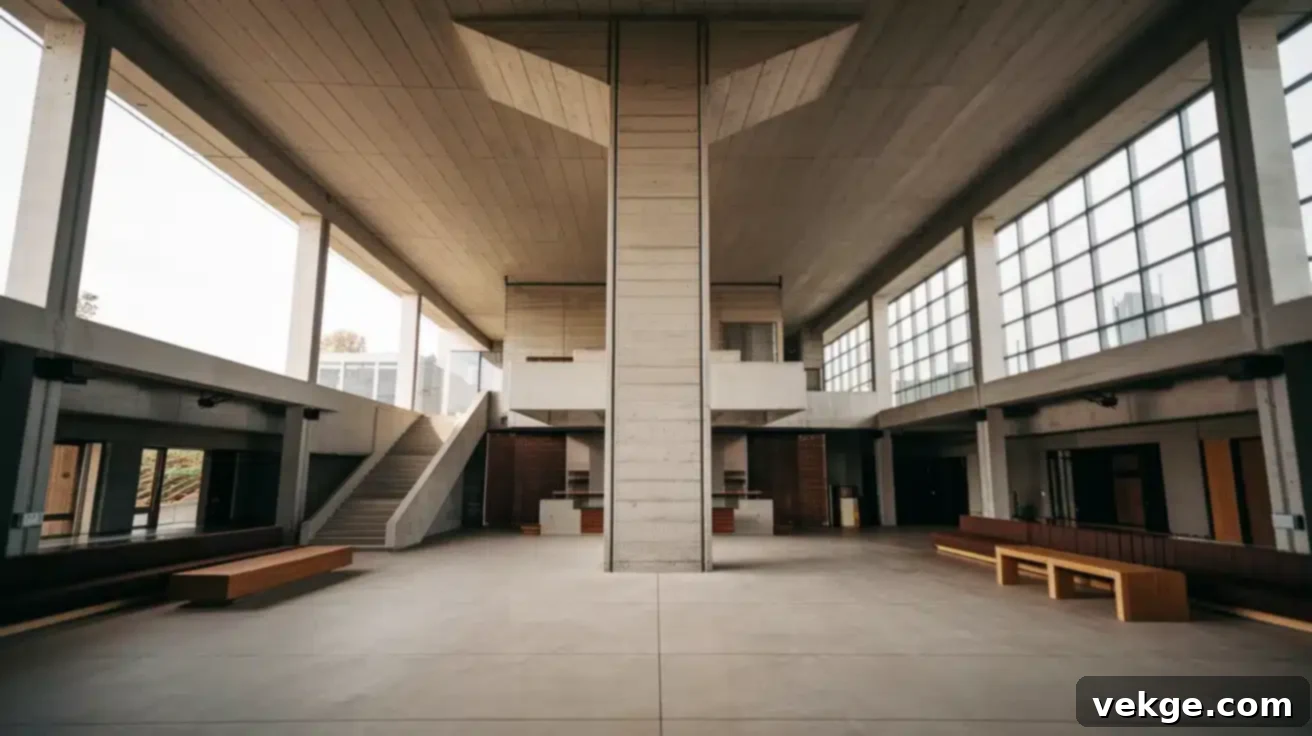
Open floor plans are a hallmark of brutalist-inspired interiors, designed to maximize the perception of space and highlight structural elements. Removing unnecessary walls between rooms can dramatically improve flow and allow natural light to penetrate deeper into the home. Instead of physical barriers, use thoughtfully placed furniture to subtly define different functional zones within the open area. This inherent openness makes the space feel considerably larger and more expansive, even in smaller residences, and provides an unobstructed canvas to showcase raw materials, rich textures, and bold design features, maximizing their visual impact.
10. Statement Art with Geometric Shapes
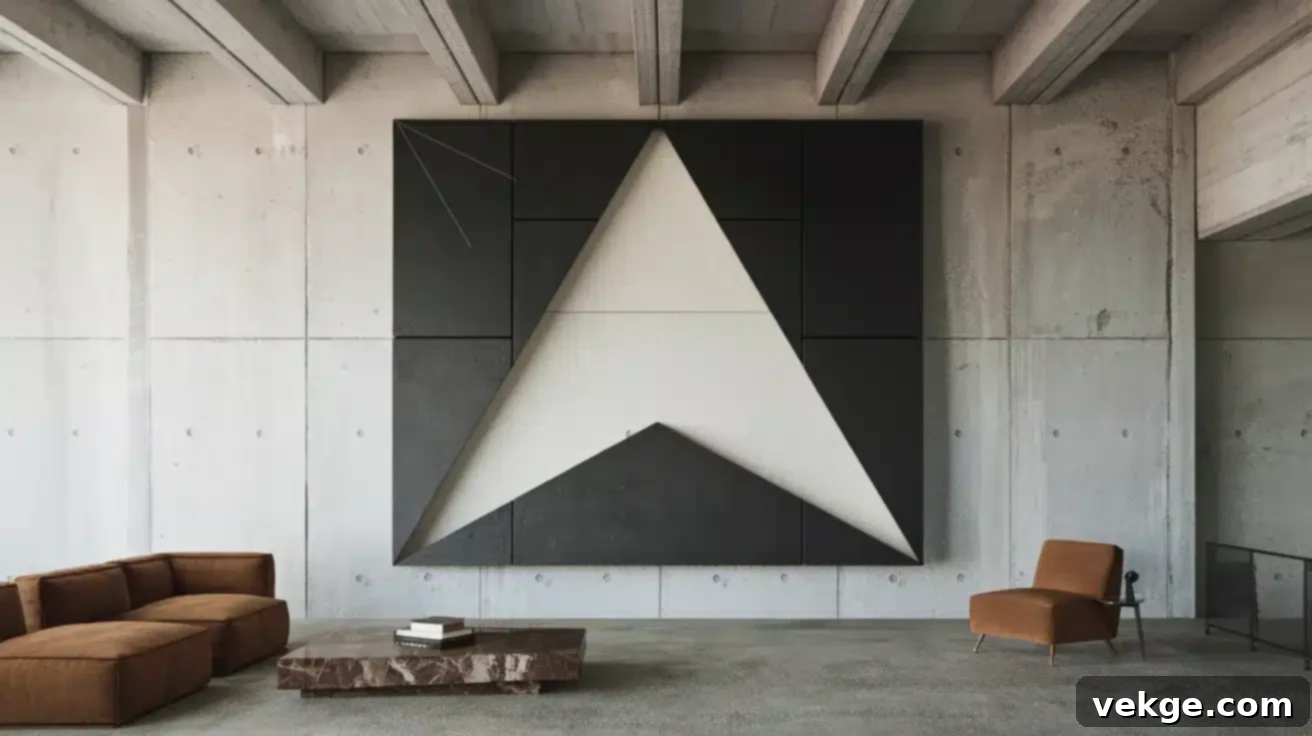
Art in a minimalist brutalist interior should be as bold and structured as the space itself. Opt for large-scale pieces featuring sharp lines, solid forms, or compelling abstract geometric shapes. Black-and-white photography, minimalist line drawings, or substantial metal sculptures are particularly effective choices. Geometric art inherently reflects the order, precision, and strength of the overall design aesthetic. One or two well-chosen, impactful pieces can infuse personality and character without introducing visual clutter. Think of them as extensions of the architecture: simple, powerful, and deeply meaningful.
11. Mixed Textures for Depth
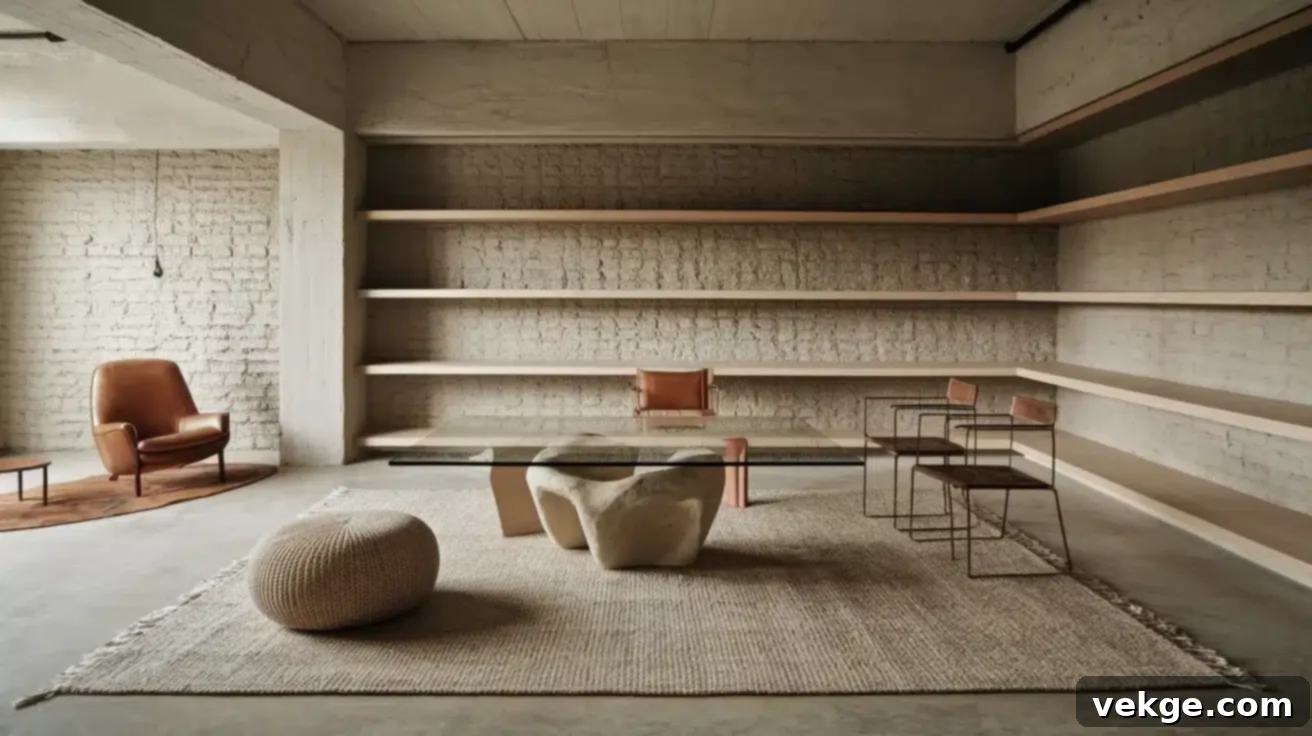
Even within a largely neutral color palette, the intelligent mixing of textures is essential to prevent a minimalist brutalist space from feeling flat or sterile. Juxtapose rough, tactile concrete with smooth, reflective glass; pair soft, inviting textiles with cool, raw metal; or combine unfinished wood with highly polished surfaces. This deliberate contrast adds rich layers of visual and tactile interest without accumulating clutter. Imagine a coarse jute rug anchoring a smooth concrete floor, or a supple leather chair positioned against a textured brick wall. This thoughtful play of textures creates a dynamic environment that remains true to the raw and honest principles of the design style.
12. Built-In Shelving and Storage

Built-in shelves, recessed niches, and integrated storage units are indispensable for maintaining the clean lines and uncluttered aesthetic crucial to this style. Instead of bulky, freestanding cabinets, opt for storage solutions that seamlessly blend with the walls or structural elements. Materials like concrete, natural wood, or matte black metal are ideal choices. These features offer both refined form and essential function, keeping your home meticulously organized while perfectly matching the strong, minimalist look. Built-in elements also impart a sense of intentionality and custom design, a key characteristic in brutalist-inspired interiors.
13. One Bold Color Element
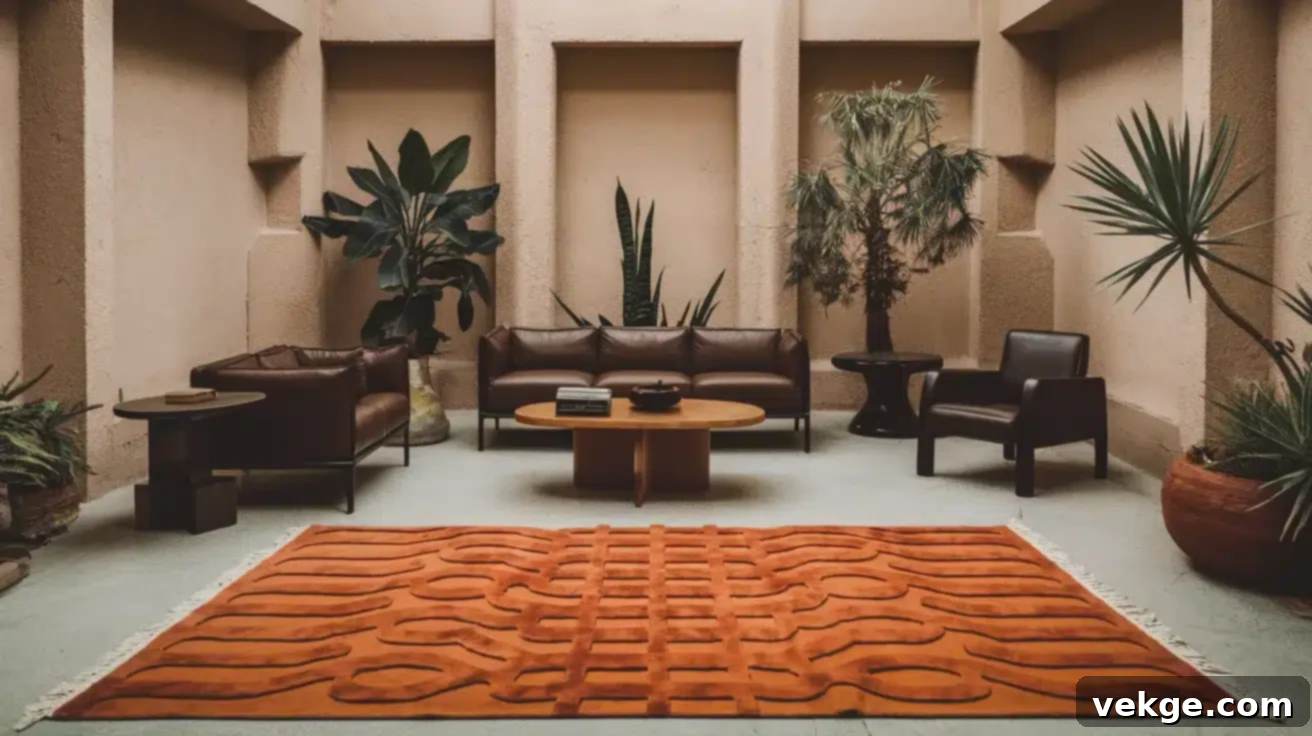
While minimalist brutalist interiors typically favor a muted, neutral color scheme, introducing a single, bold color element can be incredibly effective in creating a powerful focal point. A vibrantly colored accent chair, a deeply hued rug, or a single painted accent wall can introduce dynamic contrast without overwhelming the room. The chosen bold shade will pop against the predominantly gray, black, or white backdrop, injecting a surprising burst of energy into the space. To maintain cohesion, select just one primary accent color and perhaps echo it subtly in one or two other small accessories throughout the room.
14. Natural Light as a Design Tool
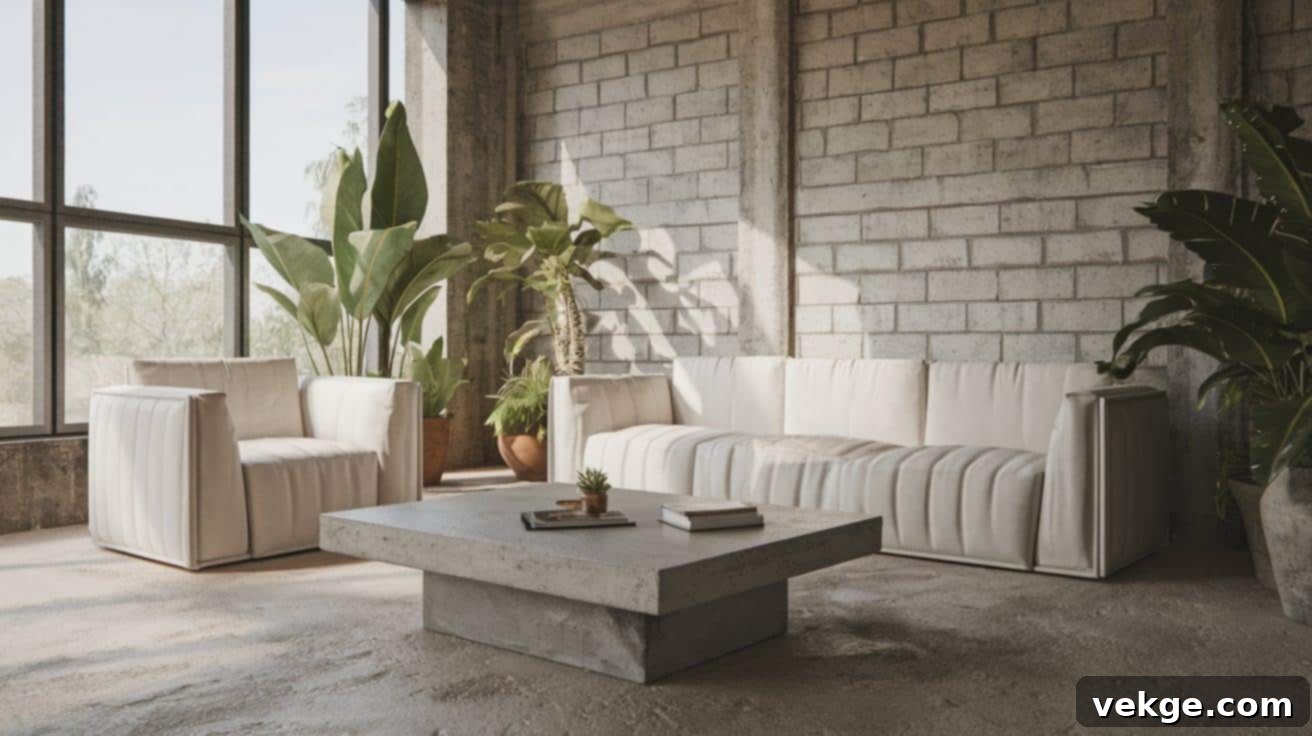
Harnessing natural light is a fundamental design tool in a brutalist space, enhancing and highlighting the raw textures and materials. Large windows, strategically placed skylights, or expansive glass doors can imbue even the heaviest materials with a sense of lightness and airiness. Avoid heavy drapes; instead, opt for sheer fabrics that diffuse light gently or, where privacy allows, leave windows uncovered entirely. The way sunlight dances across concrete, textured walls, or unfinished wood adds dynamic life and subtle movement, simultaneously helping to balance the darker tones often prevalent in this design style.
15. Imperfections that Add Character
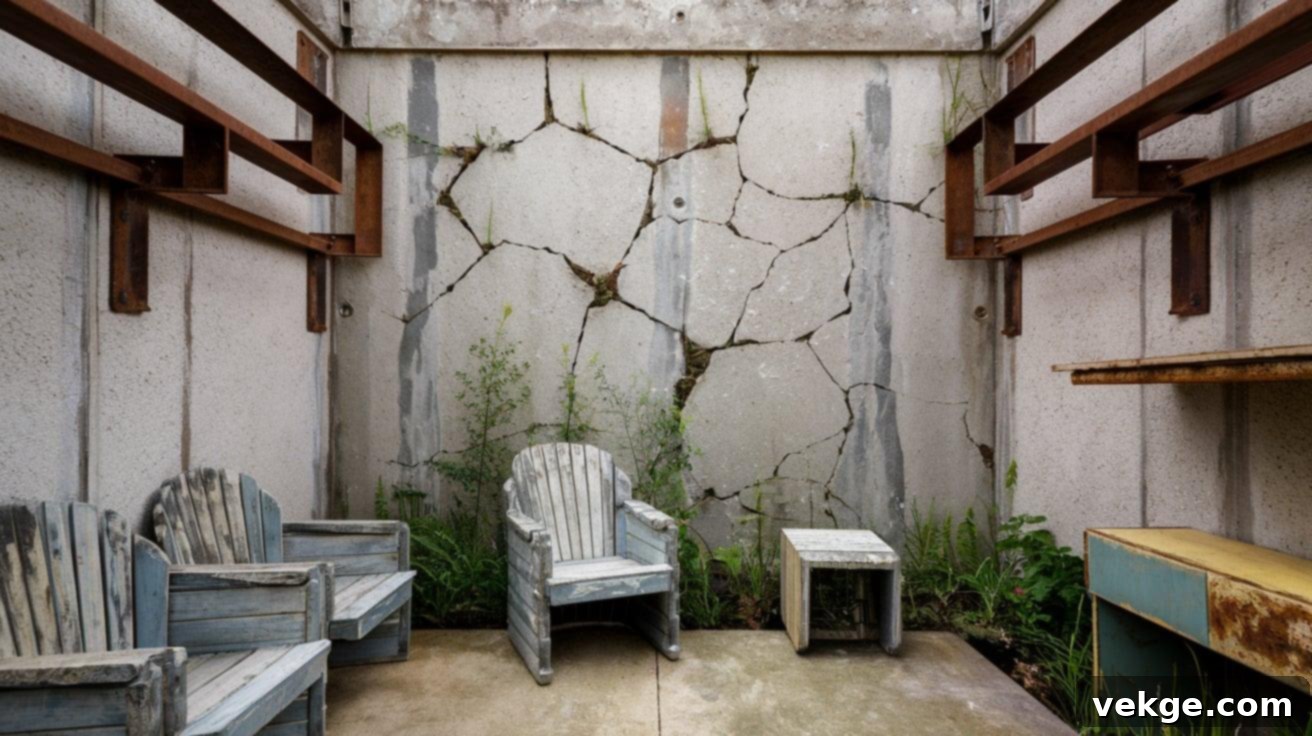
Brutalist design uniquely celebrates the natural flaws and inherent character of its materials. Minor cracks in concrete, the subtle wear of aged wood, or the gentle patina of rusted metal are not viewed as defects but rather as integral parts of the material’s story and charm. These imperfections lend the space an authentic, lived-in feel, injecting warmth and personality into an otherwise strong and serious aesthetic. Rather than attempting to conceal or “fix” these marks, they are often highlighted, bringing a profound sense of authenticity to the space and making each element feel real, grounded, and deeply textural.
Designing Each Room with a Minimalist Brutalist Style
By thoughtfully applying raw materials, embracing simple forms, and prioritizing functional layouts, you can seamlessly integrate minimalist brutalist interior design into every area of your home. Here’s a room-by-room guide to help you achieve this distinctive aesthetic:
Bedroom
In a brutalist-style bedroom, the focus is on creating a sanctuary of calm, structure, and elegant simplicity. Begin by anchoring the space with a striking feature, such as an exposed concrete wall or a concrete-look headboard. Furnish with clean-lined bedside tables, perhaps in matte black metal or solid wood, and install minimal lighting like industrial sconces. Storage should be discreet and integrated, like floating nightstands or sleek, open shelving that enhances the room’s spaciousness.
For bedding, choose soft, natural fabrics in neutral tones—grays, whites, earthy beiges, or muted taupes. Breathable materials like cotton or linen provide a crucial textural contrast to the harder surfaces. Resist the urge to over-decorate; instead, add warmth and depth through a woven throw, a large, undyed wool rug, or a single, impactful piece of geometric art. The result is a bedroom that feels profoundly grounded, restful, and entirely free from visual distractions.
Living Room
For the living room, select low-profile furniture that ensures clean sightlines and maintains an open, airy feel. A robust sofa with angular arms, paired with concrete or metal side tables, and open, minimalist shelving will define the space without clutter. Utilize exposed materials like original brickwork or a feature concrete wall to introduce texture and character. Metal-framed chairs or coffee tables can add an industrial edge while keeping the overall impression lightweight and structured.
Maximize natural light by employing wide windows and avoiding heavy window treatments; sheer curtains or no coverings at all are ideal if privacy permits. Introduce elements of softness through neutral textiles like cotton or wool throw pillows and a large, textured area rug. Keep accessories to an absolute minimum; a single sculptural lamp, a large black-and-white abstract print, or a substantial ceramic vase can serve as powerful visual anchors, embodying the room’s strength and intentionality.
Kitchen
The kitchen in a minimalist brutalist home should be a testament to both striking structure and impressive efficiency. Envision exposed concrete countertops, industrial-style stainless steel sinks, and sleek, flat-front cabinetry in matte black, charcoal gray, or a rich wood finish. Wall-mounted open shelving crafted from steel or raw wood offers a smart way to combine storage with display, highlighting beautiful but functional kitchenware.
Add compelling texture and contrast with raw wood cutting boards, matte black hardware, and perhaps aged metal bar stools. Pendant lights with bold, sculptural forms in steel, concrete, or raw metal will provide both task lighting and significant visual interest. Maintain clutter-free surfaces, opting for hidden compartments for essentials, and allow the inherent beauty and robustness of your chosen materials to truly speak for themselves.
Mixing Minimalist Brutalist Interior Design with Other Styles
While minimalist brutalist interior design creates a powerful statement on its own, it also possesses a remarkable versatility, blending beautifully with other popular design styles. Introducing a complementary aesthetic can subtly soften the raw edges, inject more warmth, or add a unique layer of personality to the space without compromising its core principles.
Adding Scandinavian Touches
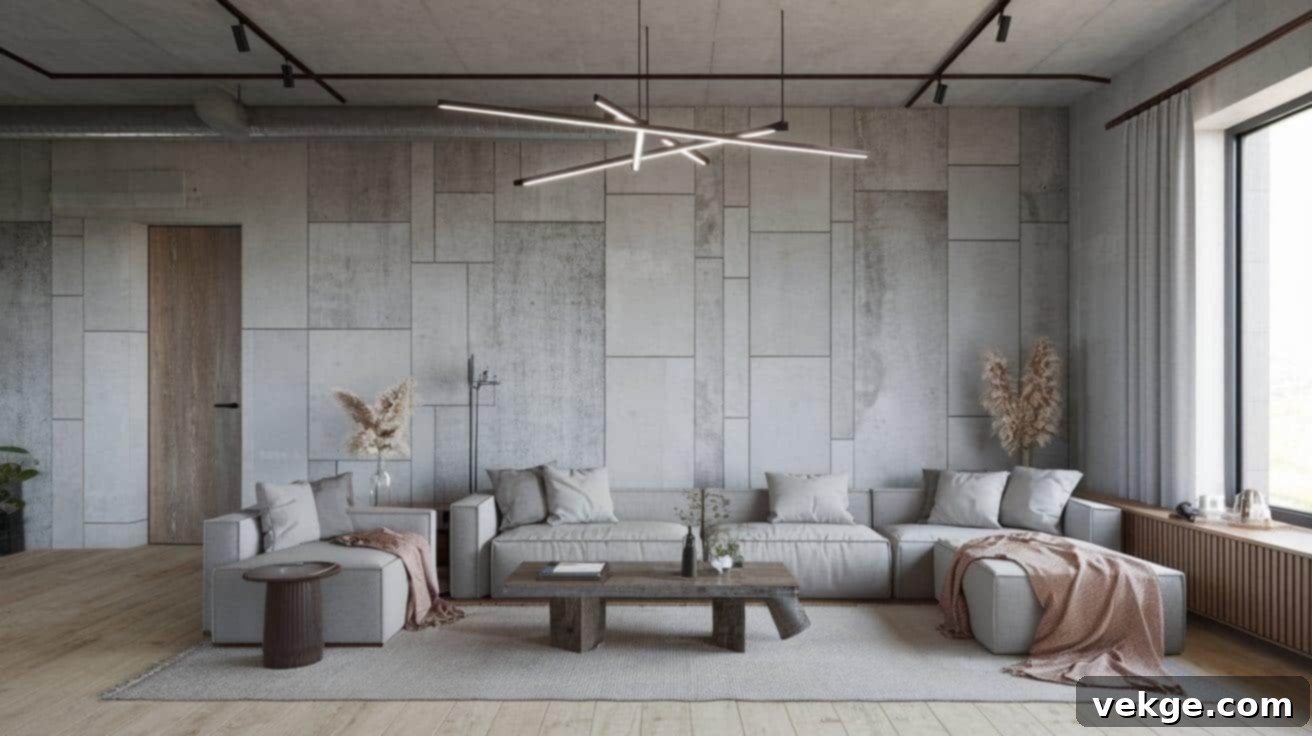
Scandinavian design is a natural partner for brutalism, as both styles highly value simplicity, functionality, and clean aesthetics. To infuse Scandinavian touches, incorporate lighter wood tones, such as birch or pale oak, which can immediately warm up the space. Introduce soft textiles and cozy fabrics like chunky wool throws, cotton cushions, or sheepskin rugs. These elements add an inviting comfort without introducing clutter, and their clean shapes and natural textures beautifully balance the starkness of concrete and metal, creating a harmonious and livable environment.
Blending with Mid-Century Modern
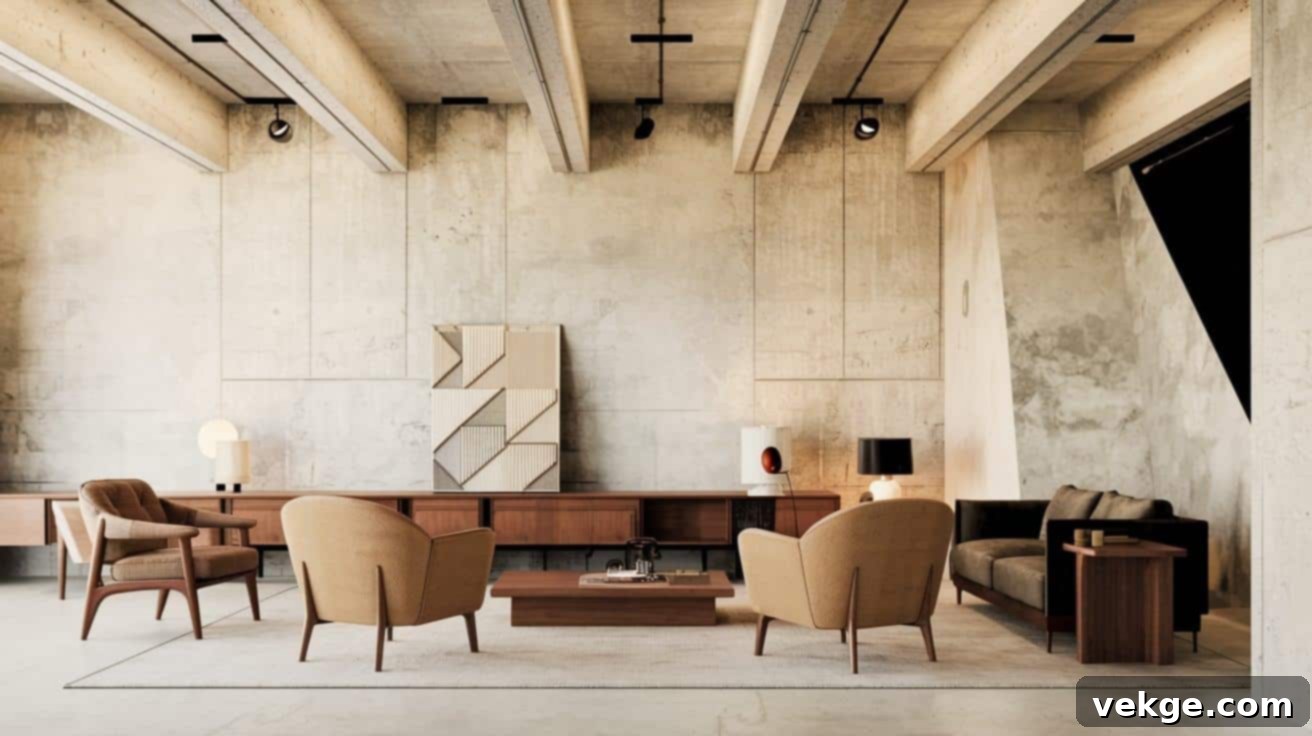
Mid-century modern design offers a delightful way to add a touch of vintage charm and sophisticated form to brutalist interiors. Seek out iconic furniture pieces characterized by clean lines, organic curves, tapered legs, and subtle sculptural qualities. Materials like rich teak or warm walnut wood can provide a striking yet complementary contrast to brutalist concrete or steel. This thoughtful combination maintains the bold and structured essence of brutalism while introducing the inviting warmth, classic elegance, and timeless character of mid-century aesthetics, resulting in a truly distinctive and refined space.
Why Minimalist Brutalist Interior Design Ideas are Exceptionally Practical
Minimalist brutalist interior design extends far beyond mere aesthetics; it is a philosophy deeply rooted in functionality and everyday living. The principles behind this style are remarkably simple to apply and prove exceptionally effective in real-world settings, from bustling city apartments to expansive modern homes. Here’s why these design ideas are inherently practical and beneficial for contemporary living.
Saves Space and Reduces Clutter
One of the most compelling advantages of this design style is its remarkable ability to optimize space, particularly beneficial in compact environments. Minimalist brutalist interiors intrinsically reject overcrowding and extraneous elements. Furniture is often low-profile and ingeniously multi-functional, featuring integrated storage in beds or built-in seating arrangements. This strategic approach liberates valuable floor space and prevents your home from feeling confined. The emphasis on clean lines and open layouts further contributes to making rooms feel considerably larger and more expansive than their actual dimensions. Even in more generously sized homes, this philosophy cultivates a profound sense of order, serenity, and essential breathing room.
Easy to Maintain
This design style is a boon for simplifying daily life and maintenance routines. With fewer pieces of furniture and a curated selection of decor, there is significantly less to clean and organize. The dominant materials—concrete, sealed wood, robust brick, and matte metals—are inherently sturdy and designed to withstand the rigors of daily wear and tear. Minor spills, superficial dents, or subtle scratches often do not detract from the aesthetic; instead, they can add to the material’s character and patina over time. Furthermore, by deliberately avoiding high-gloss finishes or delicate, fragile items, you eliminate the constant worry of touch-ups, extensive cleaning, or careful handling, allowing for a more relaxed and resilient living environment.
Budget-Friendly Options
While some premium materials can indeed be an investment, minimalist brutalist interiors can be surprisingly budget-friendly when approached with smart planning. Options like exposed concrete finishes (or concrete-effect finishes), reclaimed wood, and industrial-style lighting often present more affordable alternatives compared to high-end, custom-fabricated furnishings. Embracing DIY solutions such as simple shelving units, sourcing secondhand metal furniture, or utilizing concrete-look wallpapers can effectively achieve the desired aesthetic at a fraction of the cost. The fundamental principle of needing fewer items means you can often allocate more of your budget to one or two truly impactful, bold features rather than spreading it thinly across many less significant pieces.
Long-Lasting Design
A significant strength of minimalist brutalist design is its deliberate avoidance of fleeting trends. Instead, it anchors itself in the enduring appeal of lasting materials and timeless, fundamental shapes. Materials like concrete, steel, and natural wood possess inherent longevity; they do not rapidly go out of style and, in fact, often gain character and beauty as they age and acquire a natural patina. This translates into a sustainable investment in design, eliminating the constant pressure to refresh your space to keep pace with popular fads. It’s a robust design choice that will remain relevant and aesthetically pleasing for many years to come.
Common Mistakes to Avoid in Minimalist Brutalist Design
While minimalist brutalist design is celebrated for its bold aesthetic and practical benefits, it’s easy to push the boundaries too far, resulting in a space that feels unwelcoming or overly austere. Avoiding these common pitfalls will help you cultivate a balanced, comfortable, and truly livable environment.
- Overusing Dark Tones: An excessive reliance on dark grays, blacks, or dense concrete can make a space feel heavy, gloomy, or closed in. To counteract this, ensure ample natural light, use sheer or light-colored window coverings, and introduce lighter-toned accents in textiles or small decor items.
- Forgetting Warmth and Softness: Exclusive use of hard materials like concrete, steel, and glass can create an environment that feels cold and uninviting. Always integrate elements that provide warmth and softness, such as raw wood, plush textiles (wool, linen, cotton), comfortable rugs, and vibrant green plants.
- Cluttering with Decor: The essence of brutalism and minimalism is simplicity. Resist the urge to fill every surface with trinkets. Instead, adhere to the principle of “less is more” by selecting only a few impactful, sculptural, or truly meaningful decorative pieces that enhance, rather than detract from, the clean design.
- Prioritizing Style Over Function: Brutalist interiors are fundamentally designed to be functional and purposeful. Never choose a piece of furniture or decor solely for its appearance if it doesn’t serve a practical purpose or enhance usability. Every element should contribute to the efficiency and ease of living within the space.
- Ignoring Maintenance Needs of Raw Materials: While raw materials are celebrated, they often require proper care and sealing. Concrete, unfinished wood, and certain metals, if left untreated, can be susceptible to stains, cracks, or corrosion over time. Ensure you understand and address the specific maintenance requirements of each material to preserve its integrity and aesthetic appeal.
Conclusion
Minimalist brutalist interior design offers a powerful and refreshing approach to crafting compelling living spaces. By embracing raw materials, simple yet robust forms, and highly practical layouts, this style creates environments that are inherently strong, honest, and wonderfully clutter-free. It seamlessly adapts to both compact urban apartments and expansive modern homes, delivering sophisticated style without the burden of excessive ornamentation.
By thoughtfully integrating elements like exposed concrete, industrial steel, warm natural wood, and abundant natural light, you can build a living space that feels both dramatically bold and profoundly livable. Whether you choose to implement just one of these ideas or embark on a complete design transformation, each element contributes a unique touch of purpose and enduring character.
If your quest is for a clean, grounded, and resilient design aesthetic that transcends fleeting trends, minimalist brutalist interior design unequivocally checks all the boxes. It is a style that is simple, authentic, and truly built for real life.
